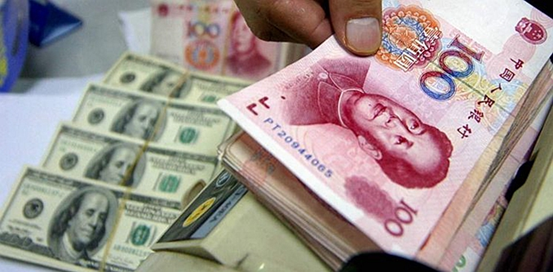
The yuan's central parity exchange rate against the US dollar rose to 6.4335 on Wednesday, setting a new two-year high.
It was the fifth consecutive trading day rise of the yuan against the dollar.
In 2017, the yuan's central parity rate against the dollar rose by 6.16 percent and the market exchange rate increased by 6.72 percent, according to data from chinamoney.com.cn, official website of the China Foreign Exchange Trade System.
It was a different story in 2016. By the end of that year, the dollar had hit a fresh 14-year high while the yuan dropped to an eight-year low against the dollar.
“The yuan will 'automatically' stabilize this year amid a firming economy and global confidence in the country's growth prospects,” central bank governor Zhou Xiaochuan said in March 2016.
The Central Economic Work Conference at the end of 2016 defined the yuan's trend, saying that it was necessary to enhance the flexibility of the exchange rate, while maintaining the yuan's stable range at a reasonable and balanced level.
The Chinese government in recent years has implemented reforms to create a domestic currency mechanism more market-orientated.
The value of the yuan is fundamentally related to the nation's economic development level. Compared with developed countries, the Chinese economy in general has enjoyed rapid growth, with fast improvement of income levels and productivity. Conditions in China picked up in many industries in 2017. Expectations for China's economy in 2018 are very optimistic, with a forecast of 6.7 percent growth, according to the World Bank. Therefore, it is reasonable for its currency to appreciate.
The central bank has increasingly relied on open market operations for liquidity management.
Experts forecast that the yuan's strength reflects a combination of factors. In particular, China's economy is improving, providing strong support for the stability of the yuan's exchange rate.
Since 2017, besides the US dollar, the yuan has also appreciated against the euro, yen and pound.
China's economy maintains a steady and rapid growth and strides toward high-quality development.
In December 2017, China’s foreign exchange reserves rose to their highest in more than a year, blowing past economists’ estimates, as tight regulations and a strong yuan continued to discourage capital outflows, central bank data showed on January 7.
Notching up their 11th straight month of gains, reserves rose to $3.14 trillion, the highest since September 2016 and the biggest monthly increase since July 2017.
The yuan's international status is also an important factor for its strength.
The Deutsche Bundesbank said it would add the yuan to its currency reserves on Monday.
France's central bank, Banque de France, said on Monday it already held some currency reserves in yuan, hours after the German central bank's announcement to move some of its reserves to the Chinese currency.
In the first half of 2017, the European Central Bank added the equivalent of 500 million euros in yuan to its foreign exchange reserves.
More than 60 countries and regions will include the yuan to their foreign exchange reserves, including Singapore and Russia.
The Central Economic Work Conference held in December 2017 said that China will stay on course for a proactive fiscal policy and prudent monetary policy in 2018 to foster high-quality development while containing financial risks.
(Compiled by Dong Feng)


